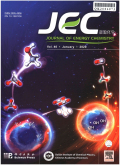- 钛学术文献服务平台 \
- 学术期刊 \
- 工业技术期刊 \
- 石油与天然气工业期刊 \
- 能源化学期刊 \
Construction of TiO2-covalent organic framework Z-Scheme hybrid through coordination bond for photocatalytic CO2 conversion
Construction of TiO2-covalent organic framework Z-Scheme hybrid through coordination bond for photocatalytic CO2 conversion
基本信息来源于合作网站,原文需代理用户跳转至来源网站获取
摘要:
In this work,a covalent organic framework (COF),which is constructed by the building blocks of[5,10,15,20-tetrakis(4-aminophenyl)porphinato]copper(Ⅱ) (CuTAPP) and p-benzaldehyde,is employed to integrate with TiO2 for the purpose of establishing a Z-scheme hybrid.Within the system,isonicotinic acid performs the role of a bridge that connects the two components through a coordination bond.Further photocatalytic application reveals the hybrid framework is able to catalyze CO2 conversion under simulated solar light,resulting in CO production rate of 50.5 μtmol g-1 h-1,about 9.9 and 24.5 times that of COF and pristine TiO2,respectively.The ameliorated catalytic performance owes much to the por-phyrin block acting as photosensitizer that augments the light absorbance,and the establishment of Z-scheme system between the inorganic and organic components that enhances the separation of the car-riers.In addition,the chemical bridge also ensures a steady usage and stable charge delivery in the catal-ysis.Our study sheds light on the development of versatile approaches to covalently incorporate COFs with inorganic semiconductors.

推荐文章
CO2 emission and organic carbon burial in the Xinanjiang Reservoir
The Xinanjiang Reservoir
Carbon emission
Sediment
Carbon retention
Pd-Rh/TiO2光催化CO2氧化乙烷脱氢研究
催化
烷烃
二氧化碳
氧化
脱氢
二氧化钛
钯
铑
TiO2掺杂对Na2CO3/Al2O3吸收剂CO2捕捉性能的影响
CO2捕捉
Na2CO3/Al2O3
TiO2
热重
掺杂
CO2气氛中TiO2催化乙苯脱氢制苯乙烯的研究
二氧化钛
催化荆
乙苯
脱氢
苯乙烯
二氧化碳
内容分析
关键词云
关键词热度
相关文献总数
(/次)
(/年)
引文网络
引文网络
二级参考文献 (0)
共引文献 (0)
参考文献 (0)
节点文献
引证文献 (0)
同被引文献 (0)
二级引证文献 (0)
2022(0)
- 参考文献(0)
- 二级参考文献(0)
- 引证文献(0)
- 二级引证文献(0)
引文网络交叉学科
相关学者/机构
期刊影响力
能源化学
主办单位:
中国科学院大连化学物理研究所
中国科学院成都有机化学研究所
出版周期:
双月刊
ISSN:
2095-4956
CN:
10-1287/O6
开本:
出版地:
大连市中山路457号
邮发代号:
创刊时间:
语种:
eng
出版文献量(篇)
2804
总下载数(次)
0
总被引数(次)
7996
期刊文献
相关文献
推荐文献
- 期刊分类
- 期刊(年)
- 期刊(期)
- 期刊推荐
一般工业技术
交通运输
军事科技
冶金工业
动力工程
化学工业
原子能技术
大学学报
建筑科学
无线电电子学与电信技术
机械与仪表工业
水利工程
环境科学与安全科学
电工技术
石油与天然气工业
矿业工程
自动化技术与计算机技术
航空航天
轻工业与手工业
金属学与金属工艺
能源化学2022
能源化学2021
能源化学2020
能源化学2019
能源化学2018
能源化学2017
能源化学2016
能源化学2015
能源化学2014
能源化学2013
能源化学2012
能源化学2011
能源化学2010
能源化学2009
能源化学2008
能源化学2007
能源化学2006
能源化学2005
能源化学2004
能源化学2003
能源化学2002
能源化学2001

 免费查重
免费查重










